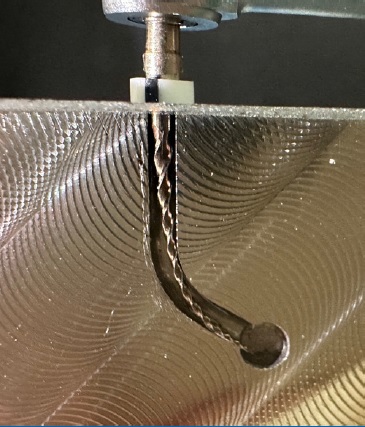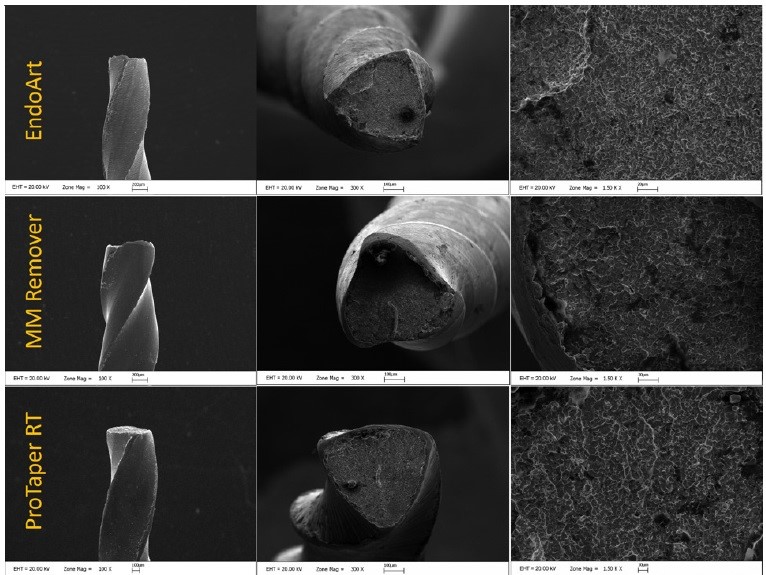Introduction
Manual endodontic hand instrumentation techniques used to remove gutta-percha from root canals in retreatment procedures are difficult and time-consuming. Thus, nickel-titanium (NiTi) rotary file systems for root canal filling removal have been suggested, and various retreatment file systems have been developed. However, NiTi files are likely to be vulnerable to fracture during clinical use. The root canal retreatment procedure will decrease the mechanical strength of NiTi tools and increase the frequency of file breakage. Heat-treated NiTi alloy provides a stronger crystal structure configuration, leading to greater stability and improved tolerance to fatigue or plastic behavior.
When a file is rotated in a curved canal and exposed to repeated compressive and tensile forces, cyclic fatigue (CF) failure may occur.1 CF failure has been related to file kinematics, metallurgical qualities of the file, operating environment, cross-sectional field, core mass, and file taper.1-4CF resistance is the number of cycles a file can endure under repetitive cycles of stress and compression until the disruption of its lifespan and its scattering; the file’s deflecting load varies during the CF period.5 Another key aspect influencing CF resistance is the environmental temperature during the tests. Simulated intra-canal temperatures have been shown to reduce the CF resistance of NiTi files and disclose their true behavior in clinical situations.6-8
ProTaper retreatment files (Dentsply Maillefer, Ballaigues, Switzerland) are conventional files (non-heat-treated) designed to simplify filling content removal, with varying dimensions, tapers, and apical tip diameters for each file.9 In order to allow initial penetration into the filling material, the D1 file (30.09) is 16 mm long and has an active tip. The D2 file (25.08) is 18 mm long, has a non-active tip, and is used at the middle third of the root canal. The D3 file (20.07) is 22 mm long and is used at working length (WL). The manufacturer recommends using this file system at between 300 and 700 rpm.
The Remover (MicroMega, Besancon, France) file is a new-generation file that is subjected to heat treatment and a proprietary thermomechanical process called C-wire that entails electro-polishing. Before using the Remover, the manufacturer recommends using an orifice modifier like the One Flare (MicroMega) to create a pilot hole and ensure better straight access. The Remover is used to remove filling material in the middle third of the root canal, at -3 mm of the WL. It has a non-cutting tip of 30/100 mm and a variable triple-helix cross-section, symmetrical in the first 3 mm and then asymmetrical toward the shaft. Moreover, it has a 7% taper limited to the first 10 mm, followed by a 0% taper toward the shaft to preserve periradicular dentine. The Remover has a non-active tip and mini-invasive wire diameter and is available in two lengths: 19 mm (30. 07) and 23 mm (30. 07).10 The manufacturer recommends using this file at a speed between 400 and 800 rpm and a torque of 2.5 Ncm. They also indicate its possible use in brushing and back-and-forth motions without applying apical pressure. The literature has reported that when using a remover file, it is not necessary to use solvents, which are known to be toxic and make it difficult to remove the gutta from the canal entirely.10,11
EndoArt (İnci Dental, Istanbul, Turkey) retreatment files are made of heat-treated controlled memory (CM) wires. The CM wire is obtained by heat-treating the NiTi wire to increase the austenite/martensite transition temperature to about 50 °C, resulting in endodontic instruments in the martensite phase.12
The EndoArt file system has three files: D1 (16 mm), D2 (18 mm), and D3 (22 mm). The files have a convex triangle cross-section. This system is specially produced for retreatment cases and designed to remove filling materials like gutta-percha. The manufacturer recommends using these instruments at 400 rpm and 2.5 Ncm of torque.
Several researchers have studied the CF resistance of retreatment files.13,14 However, the literature has little data on the CF resistance of heat-treated retreatment files.15 Therefore, the aim of this study was to compare the CF resistances of MicroMega Remover, EndoArt, and ProTaper NiTi retreatment files when used in curved artificial canals. The null hypothesis is that there are no statistically significant differences in C resistance among these retreatment files.
Material and Methods
Sample size and power analyses were calculated using G*Power (version 3.1.5.1, Heine Heinrich University, Dusseldorf, Germany).
A sample size of 15 per group provided 83% power with an effect size of 0.5 among the test groups (α=0.05). A total of 45 new MicroMega Remover, EndoArt D2, and ProTaper D2 retreatment files were tested using a static test model in a stainless-steel block with an internal diameter of 1.5 mm, an angle of curvature of 60°, and a radius of curvature of 5 mm, containing a curved artificial canal (Figure 1).

Figure 1 Test model in a stainless-steel block with na internal diameter of 1.5 mm, an angle of curvature of 60°, and a radius of curvature of 5 mm
The artificial canals in the stainless-steel block were empty and did not contain any gutta-percha or root canal sealer. All files were reviewed using a stereomicroscope (Carls Zeiss, LLC, Germany) at ×16 magnification prior to mechanical testing to identify any faults or abnormalities; none were discarded. The experimental system was filled with distilled water, and the ambient temperature was kept constant at 35±1°C.
The files were connected to an X-Smart Plus (Dentsply Maillefer), and, to ensure standardization, speed and torque were set to constant 350 rpm and 2.5 N/cm, respectively, in continuous rotation mode, following the manufacturers’ recommendations. The files were rotated in continuous mode until their fracture to determine the number of cycles to failure.
A chronometer was used to determine the time to fracture, and all trials were video-recorded. For each file, the number of cycles to fracture (NCF) was computed by multiplying the time to fracture by the number of rotations per minute (rpm). The length of each fragment was measured using a digital caliper (AbsoluteDigimatic, Mitutoyo Corp, Kawasaki, Japan).
All files were collected in safe-lock tubes with broken tips to take scanning electron microscopy (SEM) images. SEM was used to confirm the topographic characteristics and evaluate all equipment for fragment fractures. The files were cleaned in distilled water for 3 min in an ultrasonic device before using SEM (JSM-6060LV; JEOL Ltd., Tokyo, Japan). SEM images were taken at ×100, ×300, and ×1500 magnifications.
All data were analyzed by using the SPSS statistical software package program (SPSS version 24.0; SPSS, Chicago, IL, USA). The NCF and fragment length values were analyzed using one-way analysis of variance (ANOVA) and Tukey post-hoc tests. The statistical significance level was set at p<0.05.
Results
Table 1 presents the results for CF and lengths of fractured fragments for each group. Figure 2 shows sample SEM images. The group with the highest CF resistance was EndoArt D2, followed by MicroMega Remover and ProTaper D2 (p<0.05).
There was no difference in the lengths of broken fragments between the retreatment files (p>0.05).
Table 1 The number of cycles to failure (NCF) and fragment length (mm) of files during cyclic fatigue testing.

SD - standard deviation.
Different superscript letter indicates statistically significant difference within the same column (p<0.05)
Discussion
NiTi files are provided in three microstructural phases. The austenitic phase gives the NiTi alloy superelastic characteristics, making the files stiffer and tougher. The R-phase is a distorted rhombohedral phase before the martensitic transition. Finally, the martensitic phase enhances the alloy’s ductility, making it easier to bend and providing a memory effect.16-18
Temperature and stress induce these changes. As a result, several thermal treatments have been proposed to increase the file’s flexibility by modifying the austenite-martensite transition temperature.17 The M-Wire files’ full austenitic transition temperature is around 43-50 °C, which is lower than the temperature observed within the canal.17,18 When M-Wire files are exposed to body temperature, they include austenite phase with minor amounts of R-phase and martensite,17,19,20which improves their CF resistance compared to ordinary NiTi files.17 According to this study, heat treatment improves the CF resistance of files and the flexibility of rework tools, even when used at body temperature.
Rotary NiTi technologies outperform hand tools in eliminating root fillings.9,21 They also help reduce patient and operator discomfort.22 On the other hand, their drawbacks include a greater frequency of file breakage and more filler material left after retreatment.23-25 Previous 23,26 evaluated and compared the performance of rotary NiTi files in the removal of fillings, and all of them revealed a considerable risk of NiTi file breakage and residual root canal fillings on dentin walls.
More clinical studies, especially on the retreatment of teeth with curved canals, are needed to understand whether the increased durability of heat-treated files makes a difference in their effectiveness.
This study used Remover, EndoArt D2, and ProTaper D2 files from retreatment file systems of different brands. According to the manufacturers, all three files are indicated for the middle third of the canal. They also do not recommend reaching the apical third with any of the three files. For this reason, this study compared these three equivalent files of diferente systems.
Özyürek et al.14 investigated the effect of adaptive motion on the CF resistance of the ProTaper Universal D1 NiTi file designed for retreatment and reported that the adaptive motion program significantly increased the resistance to CF. Topçuoğlu et al.13 compared the CF resistance of D-RaCe DR2 and Pro-Taper D3 rotary NiTi retreatment files in curved artificial canals and reported that the CF resistance of the D-RaCe file was higher.
They stated that this result could derive from the smaller cross-section and taper that makes the D-RaCe DR2 file more flexible than the ProTaper D3. In the present study, CF resistance was highest with EndoArt D2, followed by Remover and ProTaper D2. The lowest CF strength of the ProTaper D2 file may be due to its non-heat-treated metallurgical structure and convex triangular cross-section. The lower CF strength of the Remover file compared to the EndoArt D2 file may result from the Remover instrument’s C-wire composition and variable triple- helix cross-section; however, no similar study was found comparing the retreatment files used in this study. Ideally, CF should be tested using natural human teeth in a clinical setting; however, standardization and repeatability of test conditions are very difficult in that scenario.27 Therefore, glass or stainless-steel cylindrical tubes and standardized simulated canals in stainless steel, ceramic, or zirconia blocks are often preferred.14,28-30 Although it does not reflect clinical conditions exactly, this study used a simulated artificial canal in a stainless-steel block to establish a standard experimental setup under in-vitro conditions.
Retreatment procedures may result in root canal transportation, which can cause lodging, zipping, and perforation, particularly in the apical region of the root canal.31 Although heat treatment will make the file less rigid and may reduce gutta engagement, it might reduce the risk of zip, perforation, logging, or transportation in the apical region. Further research is needed on this subject. This study investigated the CF resistance of three different retreatment files, but their performance in removing gutta and canal fillings was not evaluated; this may be the subject of future studies.
















